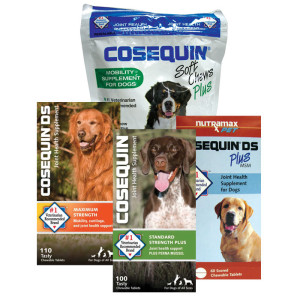Hi Pet Blog Readers,
Today we are joined by Animed, who has an informative post about dog arthritis. A painful affliction that affects dogs young and old, arthritis can be a tedious and emotional problem to treat. But as Animed describes, there are ways to help alleviate the symptoms of arthritis and allow your dog to enjoy a more comfortable lifestyle. If you have any questions, comments or personal experiences with dog arthritis that you would like to share, please let us know in the comments section below. Thanks!
_______
If your dog has been limping and displaying restricted mobility, you may be concerned about the possibility of arthritis. Other symptoms of canine arthritis can include favoring particular limbs, expressing difficulty in getting into a standing position, joints that appear stiff and painful, reluctance to jump or climb stairs, a lack of interest in playtime and exercise and behavioral changes.
The chances of developing arthritis becomes more likely as your dog gets older (especially if they are also overweight) but younger dogs can also be affected by the condition after infection, injury or trauma to the joints. Inherited conditions such as hip dysplasia can also encourage arthritis. Here’s what to expect if you suspect that your dog may have developed arthritis.
Speak to Your Vet
If you’re worried that your dog may have developed arthritis, speak to your vet about any worrying signs. This will set the ball rolling on getting an official diagnosis and paves the way for putting together a treatment plan.
Diagnosing Your Dog’s Arthritis
A physical examination is likely to be conducted as the first part of diagnosing your dog. Depending on the outcome of this, X-rays may then be recommended to confirm an arthritis diagnosis. X-rays are particularly useful in diagnosing canine arthritis.
Living With Your Dog’s Arthritis
Generally speaking, canine arthritis is a degenerative condition. This means that it will usually get worse over time. Affected dogs can be in a lot of discomfort, which would have a big impact on their well-being as well as their physical health. This is difficult to deal with as a pet owner but there is some good news: treatment can help your dog to have an improved quality of life.
 The first step is to find ways to manage arthritis pain. There are a number of options that can be tried to reduce your dog’s discomfort, including Non-Steroidal Anti-Inflammatory Drugs (NSAIDs) and non-prescription treatments containing glucosamine and omega-3 fatty acids, which have also been shown to have some positive effects for arthritis. NSAIDs are commonly tried first, and can be combined later with over-the-counter supplements.
The first step is to find ways to manage arthritis pain. There are a number of options that can be tried to reduce your dog’s discomfort, including Non-Steroidal Anti-Inflammatory Drugs (NSAIDs) and non-prescription treatments containing glucosamine and omega-3 fatty acids, which have also been shown to have some positive effects for arthritis. NSAIDs are commonly tried first, and can be combined later with over-the-counter supplements.
Your dog will also benefit from some health and lifestyle changes. A healthy, balanced diet is key, as is gentle exercise that will not put too much stress on your dog’s joints. While exercise will generally be uncomfortable, low impact options such swimming and walking will help your dog to maintain a healthy weight and will not add too much stress to the joints. Painful joints mean that weight gain is often a side effect of canine arthritis and this problem can make pain and discomfort worse by placing additional stress on the joints. If your dog is overweight, losing weight is strongly recommended.
 That Pet Blog That Pet Place Pet Blog
That Pet Blog That Pet Place Pet Blog
